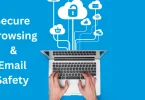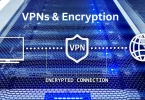In today’s digital age, where cyber threats are becoming increasingly sophisticated, understanding how to protect your online presence is more crucial than ever. Whether you’re an individual trying to safeguard your personal data or a business looking to secure sensitive information, staying ahead of cyber risks can feel like an overwhelming task. Fortunately, with the right cybersecurity tips and tools, you can effectively guard yourself against the most common—and even some of the most advanced—cyber threats.
This guide will walk you through essential tips and introduce you to cutting-edge tools that make protecting your digital world simpler and more effective than ever.
Why Cybersecurity Matters

Cybersecurity is no longer an option; it’s a necessity. In a world where nearly every aspect of our lives is online, from financial transactions to personal communications, the risk of cyberattacks is ever-present. Hacking, phishing, malware, and identity theft are just a few of the dangers lurking on the internet. The consequences of a successful attack can be severe—ranging from stolen credit card information and ruined reputations to complete financial losses and the exposure of sensitive business data. Understanding how to protect your devices, data, and digital presence is your first line of defense. While large corporations often have IT teams dedicated to cybersecurity, individuals and small businesses can also take simple but effective steps to reduce risks. The key is awareness and using the right cybersecurity tips & tools to create strong defenses.
Key Cybersecurity Threats to Watch Out For
Phishing Attacks
Phishing is one of the most common and dangerous cybersecurity threats. Attackers often impersonate legitimate organizations or individuals to trick people into revealing sensitive information such as passwords or credit card details.
How to avoid phishing attacks:
- Be cautious of unsolicited emails, messages, or phone calls asking for personal or financial information.
- Always check the sender’s email address carefully for suspicious variations.
- Avoid clicking on links in emails or text messages from unknown senders.
Malware and Ransomware
Malware refers to malicious software designed to disrupt, damage, or gain unauthorized access to computer systems. Ransomware is a type of malware that encrypts the victim’s data and demands payment in exchange for decryption.
How to protect against malware and ransomware:
- Install and regularly update anti-malware software.
- Avoid downloading files or opening attachments from unknown or suspicious sources.
- Back up important files to prevent loss in case of a ransomware attack.
Data Breaches
A data breach occurs when sensitive information is accessed or stolen by an unauthorized person. Businesses and individuals alike are susceptible to breaches that expose personal, financial, and confidential data.
How to prevent data breaches:
- Use strong, unique passwords for each online account.
- Enable two-factor authentication (2FA) wherever possible.
- Regularly update passwords and review privacy settings on your accounts.
Social Engineering
Social engineering involves manipulating people into divulging confidential information or performing actions that compromise their security. This can happen through emails, phone calls, or social media interactions.
How to protect against social engineering:
- Stay skeptical of unsolicited requests for information.
- Educate yourself and your team (if applicable) about common social engineering tactics.
- Verify any request for sensitive information through official channels.
Essential Cybersecurity Tips for Individuals
1. Use Strong Passwords and Password Managers
One of the easiest ways for hackers to gain access to your accounts is by guessing weak passwords. It’s crucial to use strong, unique passwords for every account and avoid using the same password across multiple platforms.
Password best practices:
- Use a combination of uppercase and lowercase letters, numbers, and special characters.
- Avoid using personal information such as your name or birthdate.
- Use a reputable password manager to store and generate strong passwords.
2. Enable Two-Factor Authentication (2FA)
Two-factor authentication adds an extra layer of security to your accounts. Even if a hacker manages to steal your password, they would still need access to your secondary authentication method, like a text message or an authentication app.
Where to enable 2FA:
- Email accounts (Gmail, Outlook)
- Social media platforms (Facebook, Twitter)
- Online banking or shopping accounts (PayPal, Amazon)
3. Regularly Update Your Software and Devices
Software updates often include important security patches that protect your system from newly discovered vulnerabilities. Failing to install these updates leaves your device open to cyberattacks.
Important updates to keep track of:
- Operating system updates (Windows, macOS, Linux)
- Antivirus software updates
- App updates on smartphones and tablets
4. Be Cautious with Public Wi-Fi
Public Wi-Fi networks are often unsecured, making it easier for hackers to intercept your data. Avoid conducting sensitive activities, such as online banking or shopping, when connected to public Wi-Fi.
Safe Wi-Fi practices:
- Use a Virtual Private Network (VPN) to encrypt your data.
- Avoid accessing personal accounts on public networks.
- Use mobile data when traveling or in public spaces for greater security.
Cybersecurity Tools You Should Be Using
1. Antivirus and Anti-Malware Software

Antivirus software is a critical tool in protecting your devices from malware, viruses, and other malicious threats. It scans your system for potential risks and removes any threats it detects.
Top antivirus software to consider:
- Bitdefender
- Norton
- Kaspersky
2. VPN (Virtual Private Network)
A VPN encrypts your internet connection, hiding your online activity and protecting your data from prying eyes. This tool is especially useful when browsing public Wi-Fi networks or accessing sensitive information remotely.
Benefits of using a VPN:
- Increased online privacy and security.
- Ability to access region-restricted content.
- Protection from hackers and surveillance.
3. Password Managers
Password managers help you store, generate, and manage your passwords securely. These tools can save time and improve security by ensuring that you don’t have to remember every password and that you use strong, unique ones for each account.
Popular password managers:
- LastPass
- Dashlane
- 1Password
4. Encryption Tools
Encryption is one of the most effective ways to protect your data. It transforms readable data into a scrambled format, making it inaccessible to unauthorized users.
Encryption tools to consider:
- BitLocker (Windows)
- FileVault (macOS)
- VeraCrypt
5. Firewalls
A firewall acts as a barrier between your device and the internet, blocking unauthorized access while allowing legitimate traffic through.
Types of firewalls:
- Software firewalls for individual devices.
- Hardware firewalls for businesses or home networks.
This isn’t just content, it’s a conversation you need to be part
Guest Contributor Pieces That Boost Authority Instantly
Shocking Industry Predictions You Can’t Ignore
Engage in Ethical Tech Discussions That Spark Change
Debates & Hot Takes: Bold Opinions on Controversial Issues
Cybersecurity Tips for Businesses
1. Train Your Employees on Cybersecurity Awareness
A well-informed workforce is one of the best defenses against cyber threats. Regular training sessions can help employees recognize phishing attempts, avoid risky online behavior, and follow best security practices.
Topics to cover in cybersecurity training:
- Phishing recognition and response.
- Secure password practices.
- Safe handling of sensitive data.
2. Implement Data Encryption
Businesses handle vast amounts of sensitive data, from customer information to financial records. Encrypting this data ensures that even if it’s intercepted, it remains unreadable without the proper decryption key.
Encryption strategies for businesses:
- End-to-end encryption for communications.
- File encryption for sensitive documents.
- Encrypted cloud storage solutions.
3. Regular Security Audits
Conducting regular security audits helps identify vulnerabilities in your systems and processes. These audits ensure that your cybersecurity measures are up-to-date and effective at preventing potential breaches.
Key areas to audit:
- Network security protocols.
- Software and hardware inventory.
- User access and permission settings.
4. Secure Your Network with Firewalls and Antivirus
A multi-layered approach is vital to business security. Ensure that your network is protected with strong firewalls and antivirus software that can detect and mitigate threats in real-time.
Network security tips:
- Implement a business-grade firewall.
- Use endpoint protection software to secure all devices connected to your network.
- Monitor network traffic for unusual activity.
Conclusion
As cyber threats continue to evolve, it’s more important than ever to stay proactive in securing your digital life. Whether you’re an individual or a business, the right cybersecurity tips & tools can make all the difference in protecting your data, privacy, and peace of mind. By implementing strong security measures, staying educated on potential risks, and utilizing the best available tools, you can create a safer digital environment. Don’t wait until you become a victim of a cyberattack—act now to fortify your defenses and stay one step ahead of cybercriminals. Always remember, cybersecurity tips & tools are your first line of defense in this ever-evolving digital world.
FAQs
What are the most common cybersecurity threats?
The most common threats include phishing attacks, malware, ransomware, and data breaches. These threats can compromise personal information, steal money, or disrupt business operations.
How can I improve my online security?
To improve security, use strong, unique passwords, enable two-factor authentication, keep software updated, and avoid clicking on suspicious links or attachments from unknown sources.
Are antivirus software and firewalls enough for protection?
While antivirus software and firewalls are essential, they are not enough on their own. Regular software updates, safe online behavior, and using additional tools like VPNs and encryption are also crucial.
What tools can help protect my data online?
Cybersecurity tools like password managers, VPNs, antivirus software, and encryption tools can significantly enhance your online protection by securing your passwords, encrypting your internet connection, and preventing malware.
How often should I update my cybersecurity tools?
It’s essential to update your cybersecurity tools regularly, ideally whenever updates are available. This ensures you’re protected against the latest threats and vulnerabilities.






